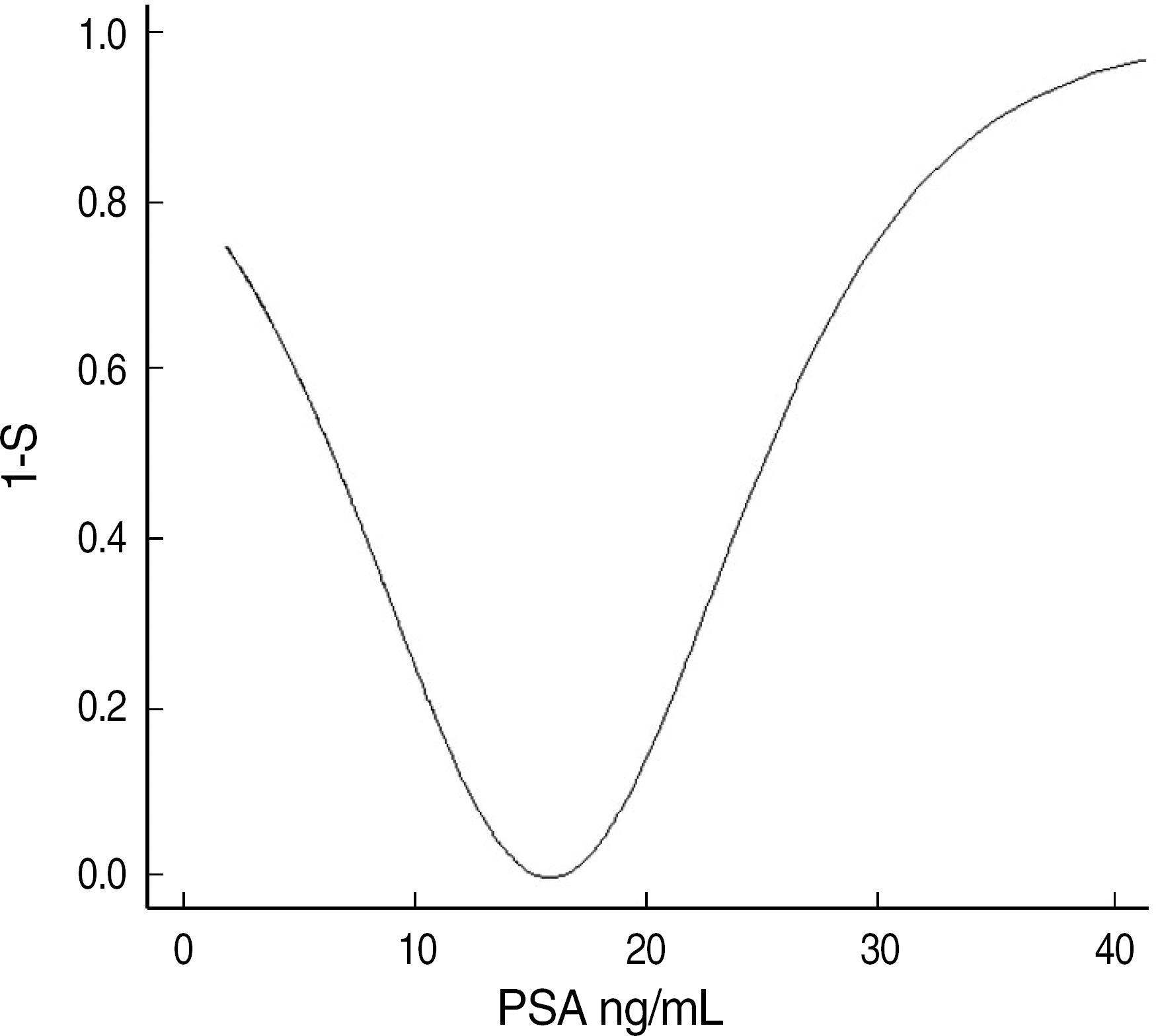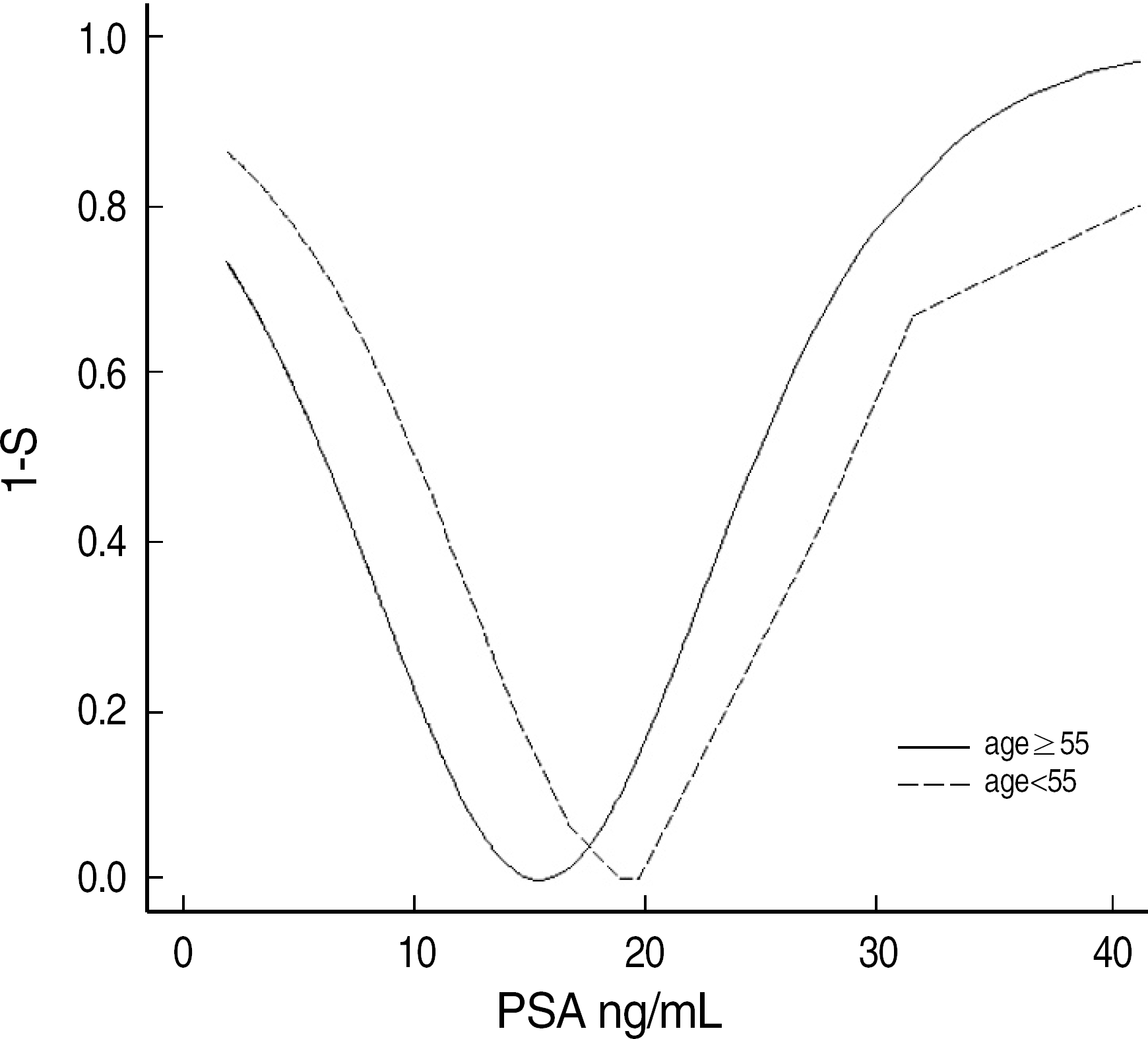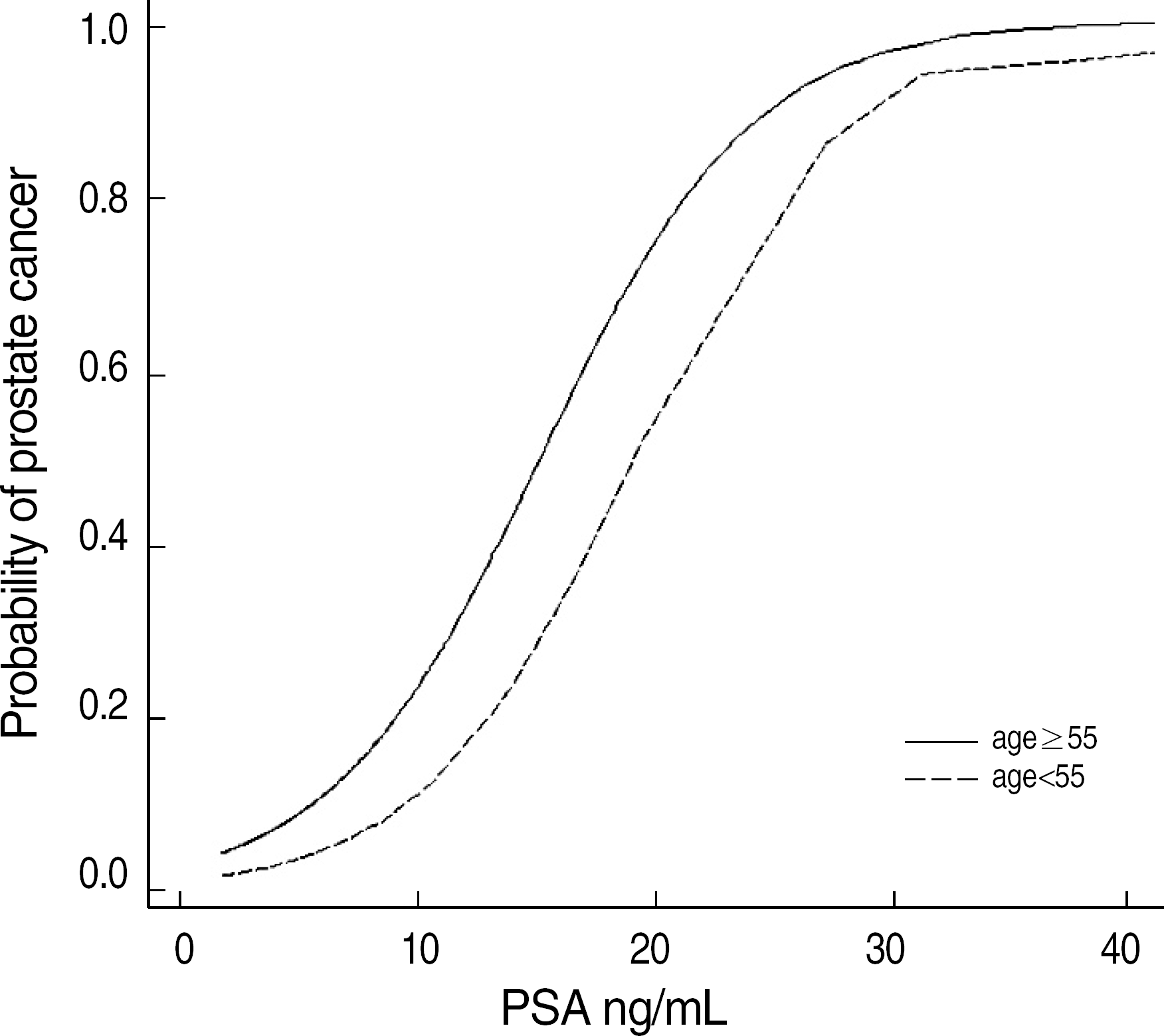Abstract
Background:
The prostate-specific antigen (PSA) is considered the most useful among tumor markers currently used. However, its quantitative results are interpreted only qualitatively for the diagnosis of prostate cancer. The recently introduced information theory enables the information of the quantitative results transformed into Shannon's entropy (S) that represents uncertainties and then “1-S” representing diagnostic certainty.
Methods:
The 882 urological patients enrolled were categorized into 2 groups: a patient group comprising 233 patients with prostate cancer and a disease control group comprising 649 patients with benign prostate disease. The level of PSA in all the patients was tested and was found to be ≥2 ng/mL. The variables like PSA level and age were modeled on logistic regression analysis to predict the probability of prostate cancer and the diagnostic certainty.
Results:
The mean (SD) of PSA levels in the patient group and the disease control group were 44.5 ng/mL (37.62 ng/mL) and 5.7 ng/mL (3.70 ng/mL), respectively. The logistic regression model fitted well when the age variable was dichotomized at the age of 55 yr. The diagnostic certainty was lowest at a PSA level of 18.90 ng/mL in the <55-yr age group, and 15.45 ng/mL in the >55-yr age group.
REFERENCES
1.Christenson RH; Committee on Evidence Based Laboratory Medicine of the International Federation for Clinical Chemistry Laboratory Medicine. Evidence-based laboratory medicine - a guide for critical evaluation of in vitro laboratory testing. Ann Clin Biochem. 2007. 44:111–30.
2.Januzzi JL Jr., Camargo CA., Anwaruddin S., Baggish AL., Chen AA., Krauser DG, et al. The N-terminal Pro-BNP investigation of dyspnea in the emergency department (PRIDE) study. Am J Cardiol. 2005. 95:948–54.

3.Vollmer RT. Predictive probability of serum prostate-specific antigen for prostate cancer: an approach using Bayes rule. Am J Clin Pathol. 2006. 125:336–42.
4.Sampson HA. Utility of food-specific IgE concentrations in predicting symptomatic food allergy. J Allergy Clin Immunol. 2001. 107:891–6.

5.Vollmer RT. Entropy and information content of laboratory test results. Am J Clin Pathol. 2007. 127:60–5.

6.Guiaşu S. Information theory with applications. New York: McGraw-Hill. 1977.
7.Rudolph RA., Bernstein LH., Babb J. Information induction for predicting acute myocardial infarction. Clin Chem. 1988. 34:2031–8.

8.Tanner MA. Tools for statistical inference: methods for the exploration of posterior distributions and likelihood functions. 3rd ed.New York: Springer;1996.
9.Ben-Josef E., Shamsa F., Forman JD. Predicting the outcome of radiotherapy for prostate carcinoma: a model-building strategy. Cancer. 1998. 82:1334–42.
10.Shannon CE., Weaver W. The mathematical theory of communication. Urbana, IL: University of Illinois Press. 1949.
11.Altman DG., Bland JM. Diagnostic tests 2: Predictive values. BMJ. 1994. 309:102.
12.Smith RA., Cokkinides V., Brawley OW. Cancer screening in the United States, 2009: a review of current American Cancer Society guidelines and issues in cancer screening. CA Cancer J Clin. 2009. 59:27–41.

13.Barry MJ. Clinical practice. Prostate-specific-antigen testing for early diagnosis of prostate cancer. N Engl J Med. 2001. 344:1373–7.
14.Catalona WJ., Smith DS., Ornstein DK. Prostate cancer detection in men with serum PSA concentrations of 2.6 to 4.0 ng/mL and benign prostate examination. Enhancement of specificity with free PSA measurements. JAMA. 1997. 277:1452–5.

15.Thompson IM., Pauler DK., Goodman PJ., Tangen CM., Lucia MS., Parnes HL, et al. Prevalence of prostate cancer among men with a prostate-specific antigen level < or =4.0 ng per milliliter. N Engl J Med. 2004. 350:2239–46.
16.Catalona WJ., Hudson MA., Scardino PT., Richie JP., Ahmann FR., Flanigan RC, et al. Selection of optimal prostate specific antigen cutoffs for early detection of prostate cancer: receiver operating characteristic curves. J Urol. 1994. 152:2037–42.
17.Morgan TO., Jacobsen SJ., McCarthy WF., Jacobson DJ., McLeod DG., Moul JW. Age-specific reference ranges for prostate-specific antigen in black men. N Engl J Med. 1996. 335:304–10.
18.Bernstein LH., Rudolph RA., Pinto MM., Viner N., Zuckerman H. Medically significant concentrations of prostate-specific antigen in serum assessed. Clin Chem. 1990. 36:515–8.

19.Kochanska-Dziurowicz AA., Mielniczuk MR., Stojko A., Kaletka J. The clinical utility of measuring free-to-total prostate-specific antigen (PSA) ratio and PSA density in differentiating between benign prostatic hyperplasia and prostate cancer. Br J Urol. 1998. 81:834–8.

20.Schroder FH., Hugosson J., Roobol MJ., Tammela TL., Ciatto S., Nelen V, et al. Screening and prostate-cancer mortality in a randomized European study. N Engl J Med. 2009. 360:1320–8.
21.Andriole GL., Crawford ED., Grubb RL 3rd., Buys SS., Chia D., Church TR, et al. Mortality results from a randomized prostate-cancer screening trial. N Engl J Med. 2009. 360:1310–9.

22.Welch HG., Schwartz LM., Woloshin S. Prostate-specific antigen levels in the United States: implications of various definitions for abnormal. J Natl Cancer Inst. 2005. 97:1132–7.

Fig. 1.
Plot of 1-S (entropy) vs. prostate-specific antigen (PSA) level to determine the diagnostic certainty of prostate cancer.

Fig. 2.
Plot of 1-S (entropy) vs. prostate-specific antigen (PSA) level for the diagnosis of prostate cancer depending on the age groups (solid line: >55 yr; discontinuous line: <55 yr).

Fig. 3.
Predictive probability curve obtained by using the logistic regression model for the diagnosis of prostate cancer in the 2 age groups.

Table 1.
Descriptive statistics
| Variable | Benign prostate disease patients (N=649) | Prostate cancer patients (N=233) | P value∗ | ||||
|---|---|---|---|---|---|---|---|
| Mean (SD) | Median | Range | Mean (SD) | Median | Range | ||
| PSA level (ng/mL) | 44.5 (37.62) | 27.36 | (2, >100) | 5.7 (3.70) | 4.57 | (2, 21.1) | <0.001 |
| Age (yr) | 69.3 (7.96) | 69 | (47, 99) | 64.7 (10.12) | 66 | (26, 88) | <0.001 |




 PDF
PDF ePub
ePub Citation
Citation Print
Print


 XML Download
XML Download